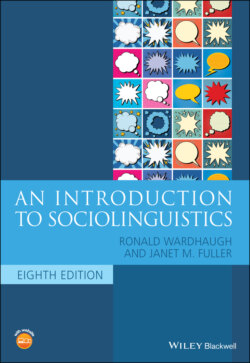Читать книгу An Introduction to Sociolinguistics - Ronald Wardhaugh, Janet M. Fuller - Страница 36
2 Languages, Dialects, and Varieties KEY TOPICS
ОглавлениеThe difference between a language and a dialect
Defining a standard/standardized language
Defining dialects by region: drawing geographical boundaries
Development of social and ethnicized dialects
How languages create meaning and how the meaning of languages is created
Indexicality and entexualization
We stated in the introductory chapter that the concept of language is considered by many sociolinguists to be an ideological construct. Further, we noted that all languages exhibit internal variation, that is, each language exists in a number of varieties and is in one sense the sum of those varieties. We use the term variety as a general term for a way of speaking; this may be something as broad as Standard English, or a variety defined in terms of location and social class (e.g., ‘working‐class New York City speech’), or something defined by its function or where it is used, such as ‘legalese.’ In the following sections, we will explore these different ways of specifying language varieties and how we define the terms ‘language’ and ‘dialect’ (regional and social). We will also address how the associations between language and social meaning develop and are used in communicating in different speech contexts.
